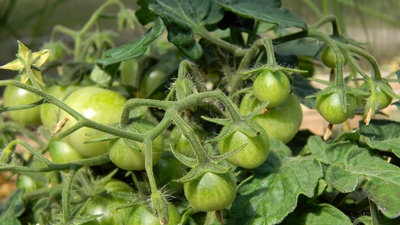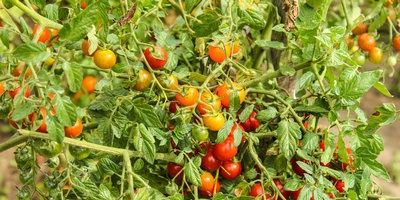|
 At the end of the last century, a cabbage butterfly fell on the cabbage. Since there were no pesticides in those days, expert gardeners mostly exchanged experiences. At the end of the last century, a cabbage butterfly fell on the cabbage. Since there were no pesticides in those days, expert gardeners mostly exchanged experiences.
So, in the same garden between the heads of cabbage cabbage settled several tomato plants. They settled themselves. When the site was weeded, they regretted it, saved it. And then, as always, the stakes were attached. Meanwhile, cabbage butterflies appeared and began "processing" cabbage. And then the owner of the garden noticed: there were no butterflies on the ridge where the tomatoes had penetrated. As if the ridge was closed by an invisible mesh.
Butterflies darted all over the garden, sat on everything else: onions and celery, on carrots and parsley, even on prickly, rough cucumber lashes. But not tomatoes! Butterflies always kept some distance with them. It happened several times that gusts of wind brought cabbages to the tomatoes. And right there, fluttering white wings, they hurried to get away from the unpleasant neighborhood. The surprised owner once gratefully stroked the stems and leaves of his defenders with his palm. There was a trace of gray-green on the fingers. The smell from the palm was sharp and unpleasant. Maybe this smell drove away annoying butterflies?
However, with cabbage, he still did not live so poorly as with turnip and radishes. The earthen flea ate them clean.
The turnips had to be sown. Sophisticated by experience, the owner planted tomato bushes next to the root crops. And - it happened! A flea on a turnip has not been seen since.
Other gardeners, naturally, began to immediately implement this experience in their plots. As a result, some thanked from the bottom of their hearts, while others scolded: tomatoes did not help. The pests have not disappeared ...
One of the gardeners helped out. And he explained it this way. The same tomato bush may or may not help. The main thing here is at what age to expect help from him. A young bush will not relieve the pest. The old thing is quite different. Over time, a gray-green bloom appears on the old one. He smears his hands. It's all about it. There is no plaque on young bushes.
 Such a simple remedy was not in use among gardeners, because the tomato itself was under suspicion. Back in the days of Empress Catherine II, it was brought to Russia, but after trying it, it was rejected. And only in recent decades, the tomato suddenly gained such popularity in the world that it surpassed all vegetables and fruits in fruit collection. He left far behind watermelons, apples and even cabbage. But only grapes still to come. But the difference between them is small, and who knows if he will overtake him in ten years? Indeed, over the current decade, grapes have multiplied their ranks by only one tenth, and a tomato three times more! Such a simple remedy was not in use among gardeners, because the tomato itself was under suspicion. Back in the days of Empress Catherine II, it was brought to Russia, but after trying it, it was rejected. And only in recent decades, the tomato suddenly gained such popularity in the world that it surpassed all vegetables and fruits in fruit collection. He left far behind watermelons, apples and even cabbage. But only grapes still to come. But the difference between them is small, and who knows if he will overtake him in ten years? Indeed, over the current decade, grapes have multiplied their ranks by only one tenth, and a tomato three times more!
With such a rapid growth in production, of course, there are still many unsolved problems. Some gardeners get 18 kilograms of fruits from a bush, others, with the most careful care, three times less. Laggards try to use different tricks. So, 80-year-old Muscovite A. Simonov began to cover them with tar paper to insulate the beds. I planted tomato bushes in the holes. The ground under the tarmac warmed up better. In addition, no weeding was required, and less watering.
He decided to put a brush of fruits in a plastic bag to protect it from any evil spirits. However, he was not lucky here. The fruits are rotten. Then the idea came to replace the film with a bag from under crisp potatoes... The replacement was successful. The fruits stopped hurting, they began to ripen and fill up much faster. Resourcefulness helped Simonov grow a variety of varieties near Moscow. He has 100 different ones every year. There are even brown and black fruits. It seems that no other vegetable crop knows such a variety of varieties in personal plots.
A. Smirnov. Tops and roots
Growing tomatoes in a greenhouse
|
 At the end of the last century, a cabbage butterfly fell on the cabbage. Since there were no pesticides in those days, expert gardeners mostly exchanged experiences.
At the end of the last century, a cabbage butterfly fell on the cabbage. Since there were no pesticides in those days, expert gardeners mostly exchanged experiences. Such a simple remedy was not in use among gardeners, because the tomato itself was under suspicion. Back in the days of Empress Catherine II, it was brought to Russia, but after trying it, it was rejected. And only in recent decades, the tomato suddenly gained such popularity in the world that it surpassed all vegetables and fruits in fruit collection. He left far behind watermelons, apples and even cabbage. But only
Such a simple remedy was not in use among gardeners, because the tomato itself was under suspicion. Back in the days of Empress Catherine II, it was brought to Russia, but after trying it, it was rejected. And only in recent decades, the tomato suddenly gained such popularity in the world that it surpassed all vegetables and fruits in fruit collection. He left far behind watermelons, apples and even cabbage. But only 





















































